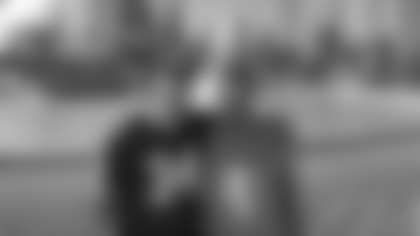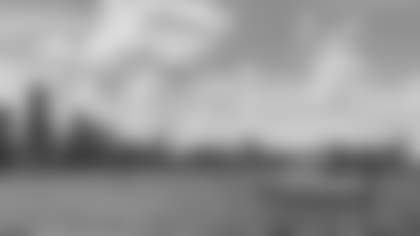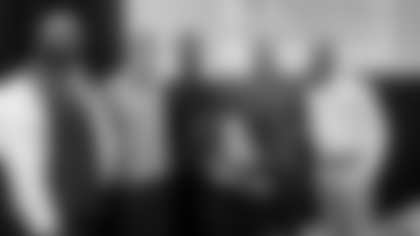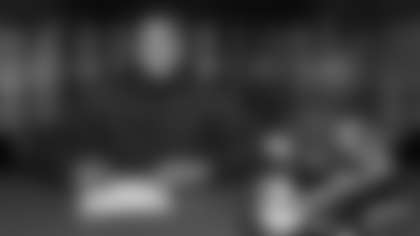Legacy along the lakefront: From the South Side to Soldier Field
Story by Gena Jones
As part of the Bears' Black History Month theme — Legacy: Creation & Celebration — student writer Gena Jones reflects on her upbringing along Chicago's lakefront, which fostered a family-wide Bears fandom and a deep passion for storytelling.
Growing up in Chicago's South Shore neighborhood, I learned one strict imperative about sports: Chicagoans always support the home team.
As an underclassman in college, I can remember always questioning other Midwesterners' fandom, sniffing out their allegiance and quickly making it known who exactly I'd be rooting for on Sundays, rain or shine.

When it comes to Chicago, possessing a die hard fandom for its sports teams also means embracing the city's culture entirely. Being born into a family with such a deep history and love for our city is what makes me passionate about telling stories of the kaleidoscope of people and cultures within Chicago.
The memories I inherited from my family are just one piece of the puzzle. I know that our love for Bears culture, the beautiful lakefront and South Side community are shared by thousands of others.
And to me, those memories were like gold.
I collected them everywhere. At any time, a casual conversation with my father on an evening cruise down Lake Shore Drive could become an oral history of 1940s Englewood. Dancing with my mom in the garage of my grandmother's Calumet City home could easily morph into a Black history lesson on stepping in Chicago. Sunday afternoons were for rest, storytimes and of course, the Bears.
An active listener with natural curiosity, I was blessed to be born into a family where the history was rich and the storytellers were skilled with the gift of gab. As I grow older, I've developed a deeper fondness for the places that birthed those memories and the Chicago culture that weaved our city's legacy into immortalized moments of my own family's history.

There is no match for a Chicago summer.
The snug warmth of our July sun will wrap around you while crowds of skaters, runners and beachgoers gather on the boulder steps of Lake Michigan's shorefront. Trails of smoke from impromptu barbecues will fill the air. R&B songs will float their way out of car windows stuck in rush hour traffic and into the ears of passersby dipping their feet into the cold lakewater.
A hot day on our lakefront is enough to make anyone a die-hard fan of the city. For me, summer days out on the water with family are what drove me to pursue a career of storytelling that highlights the culture, history and joy to be found in the Chicago experience.

"I love this place so much, I wouldn't leave here to go to Heaven."
Those are the words my father, Joseph Jones, overheard from a friend one night at 59th Street Harbor. Tucked between Lake Shore Drive and restructured lagoons from the World's Fair of 1893, our mid-sized harbor is both a beacon of city history and the site of endless family memories. My dad became a member there over 30 years ago and kept his boat in the same slip for decades. But as an 85-year-old Chicago native, he remembers a time before the lakefront became a present-day summertime heaven — a time when it was the site of the public fight for racial integration.
Right around the corner at 63rd Street Beach, my dad can still recall a chain link fence that ran vertically, extending out from the sand and into the water. The south side of the fence was home to a long stretch of sand and the huge, beautiful beach house that stands there today. The north side of the fence — the area Black people were confined to – was a small, swamp-like piece of nature full of sediment and debris.
Growing up, I nicknamed that north section of the beach Treasure Island, because it's where I would retrieve lumpy rocks and seashells to carry back to the boat. That piece of land only has a little bit of comfortable sand for beachgoers, but that's all the room that Black people were allowed to take up.
As the Civil Rights Movement progressed, wade-ins occurred across the city in an attempt to integrate Chicago's lakefront. In the late 1960s, my dad participated in one of the wade-ins at Rainbow Beach, just a few blocks south of the harbor that would eventually become a home away from home for our family.
Now a haven for the South Side Black community, that sliver of the Chicago lakefront is an irreplaceable element of my family's history. A tight-knit community of water-loving families, our old harbor is home to the waters I doggy-paddled in as an 8-year-old, splashing back and forth towards my dad as he taught me to swim.


It's the place where my dad got his nickname, Pacman Joe, the cove my nephew, Maxwell Bracey, spent every Chicago vacation in and the place where my sister, Jennifer Jones, became a true Chicago Bears fan.
"At the harbor during the warmer months, they would have viewing parties and everybody would be there decked out in their Bears gear," Jennifer recalled, fondly. "Sometimes there would be a projector in the parking lot, but sometimes we would just watch it in the clubhouse together."
Two years ago, my dad was forced to make the tough decision of selling our boat, The PacMan Joe 3. While we no longer are members, I will never forget the power of the harbor to unite people from across the city. It's a home for nearly 120 Black boat-owners, master steppers and memory-makers.

Stationed just six miles south of Soldier Field, the harbor is also the place where Bears flags fly high out on Lake Michigan. Listening intently to the conversations of Bears fans at the harbor, I learned what it means to be a passionate defender of the home team — especially against Packers fans.
But our family's fandom didn't begin or end with the harbor. My dad, sister and I spent the past December 2,000 miles away from Chicago, visiting another sister, Susan Bracey, in Los Angeles. Still, we all gathered around the TV to watch the Bears take on the Seahawks the Thursday after Christmas Day. We paused the cooking, video-gaming and trading of memories to form a new one: cheering and shouting at the game as if the players could hear us through the screen.
Max's own love for the Bears took our family's fandom to a whole new level. Despite having moved to L.A. permanently when he was 10 years old, he remained Bears faithful throughout his life and noted the influence that Black icons like Lovie Smith, Lance Briggs, and Charles Tillman had on him while growing up.
"My whole Christmas list would be Bears whatever those years: Bears watch, Bears jersey, Bears hat, I just wanted my allegiance to be known," Max laughed. "You feel like you know them, when you watch them so much. You want to emulate the way that they approach the game. I think that to have those role models, and not just as good players but good people, it meant a lot."

My mother, Myrtle Miller, now an educator in the South Suburbs of Chicago, is able to clearly see the influence that young Black athletes have on the kids she works with. The hallways are still full of Bears hats, jerseys and t-shirts every Spirit Week at school, she said with a big smile.
"It's important because they have the opportunity to see and to know that they can make it, too," my mom said. "If they stay in school, get good grades, and get on the team, they can also make it big one day."
Though she grew up directly in the shadow of Comiskey Park, the Chicago Bears fandom remained prominent in my mom's neighborhood community.
"When it came to baseball, everybody was Sox fans," she said. "And when it came to football, everybody was Chicago Bears fans."
Any person, whether they come from Chicago-proper, are a suburban transplant or Bears fan shouting at their TV from thousands of miles away, can speak to the testament of Black excellence represented in our city. From North to South, our lakefront is full of everyday stories that can fuel social impact for years to come.
Memories of wade-ins and touchdowns for some, become changemaker-inspiring history for others.
That's the legacy of my family.
That's the legacy of our city.







